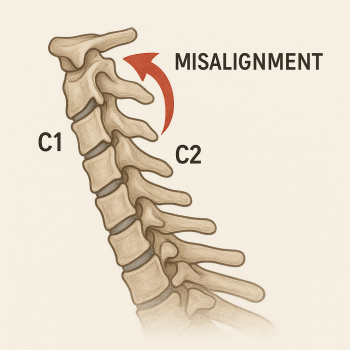
There’s a small but powerful region at the top of your spine, where your head meets your neck, that quietly controls balance, posture, and even how your nervous system communicates with the rest of your body.
When this area, the upper cervical spine, shifts even slightly out of alignment, the effects can ripple through your whole system.
As a specialist in upper cervical chiropractic care in Pleasanton, Dr. Thomas Forest often sees how correcting these subtle misalignments can help people finally find relief from persistent, unexplained symptoms.
Here are the top five signs your upper cervical spine might need attention.
1. Chronic Neck Stiffness or Pain
The atlas (C1) and axis (C2) vertebrae sit just beneath the skull and support your head’s movement. When these vertebrae rotate or tilt out of their ideal position, muscles tighten to compensate.
Over time, that tension can become chronic, limiting movement and triggering ongoing pain. If you wake up with neck stiffness more often than not, it might be more than just “sleeping wrong.”
2. Recurring Headaches or Migraines
Upper cervical misalignments can place pressure on the brainstem and nearby nerves, disrupting normal blood flow and nerve signaling.
According to neurological anatomy references, irritation near the suboccipital region can affect the trigeminal nerve pathways, often linked with tension headaches and migraines.
Many patients who visit Dr. Forest for recurring headaches notice significant improvement once their neck alignment is restored.
3. Dizziness or Balance Problems
Your upper neck houses proprioceptive nerves that constantly send balance information to the brain. Even a small shift in this area can confuse those signals, leading to dizziness or that “off-balance” sensation.
Upper cervical adjustments help restore normal neurological communication between the spine and inner ear structures, supporting better equilibrium and coordination.
4. Shoulder, Back, or Jaw Imbalances
When the atlas is out of alignment, the body compensates. One shoulder may sit higher, the hips may rotate, or even the temporomandibular joint (TMJ) can become strained.
Over time, this misalignment chain can cause uneven wear on joints and muscles throughout the spine. Correcting the upper cervical area helps the rest of the body return to a natural, balanced state.
5. Unexplained Fatigue or “Brain Fog”
The upper cervical spine protects the lower brainstem, a vital communication hub for your entire nervous system. When alignment here is disrupted, nerve signals and blood flow between the brain and body can be affected.
That often manifests as fatigue, poor concentration, or the sense that your body just isn’t “running right.” By reestablishing proper alignment, many patients report clearer thinking, better sleep, and renewed energy.
Why Choose Dr. Thomas Forest in Pleasanton
Dr. Forest uses precise diagnostic imaging and gentle correction techniques designed to restore alignment without forceful manipulation.
His approach emphasizes long-term spinal stability and natural nerve function, helping patients regain comfort and control over their health.
If you’ve been struggling with persistent headaches, dizziness, or neck stiffness, your upper cervical spine might be the missing link.
Dr. Thomas Forest – Upper Cervical Chiropractor
📍 4224 Stanley Blvd, Pleasanton, CA 94566
📞 Call today (925) 846-3357 to schedule your consultation and learn how upper cervical alignment can change your health from the inside out.





Leave a comment